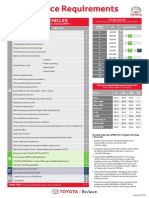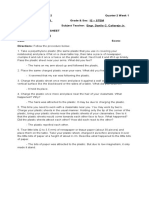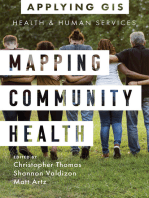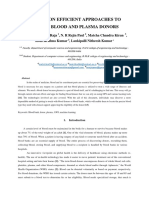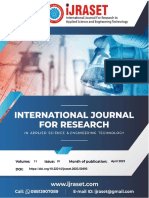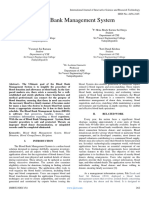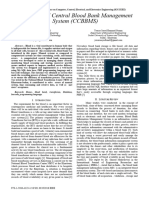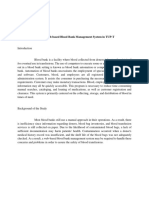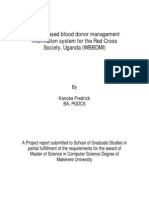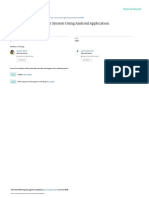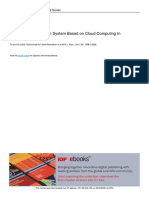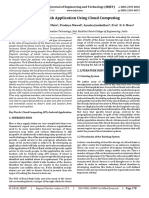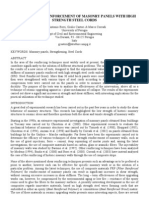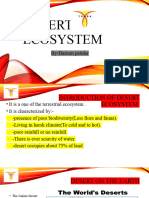Professional Documents
Culture Documents
REDLINE - An Application On Blood Management
REDLINE - An Application On Blood Management
Original Title
Copyright
Available Formats
Share this document
Did you find this document useful?
Is this content inappropriate?
Report this DocumentCopyright:
Available Formats
REDLINE - An Application On Blood Management
REDLINE - An Application On Blood Management
Copyright:
Available Formats
Volume 9, Issue 4, April – 2024 International Journal of Innovative Science and Research Technology
ISSN No:-2456-2165 https://doi.org/10.38124/ijisrt/IJISRT24APR443
REDLINE– An Application on Blood Management
Akash James Dr. Praveen Kumar Kollu Pavan Kumar Pokuri Lalithya Pavan Uriti
Department of Computer Department of Computer Department of Computer Department of Computer
Science and Engineering Science and Engineering Science and Engineering Science and Engineering
Velagapudi Ramakrishna Velagapudi Ramakrishna Velagapudi Ramakrishna Velagapudi Ramakrishna
Siddhartha Engineering Siddhartha Engineering Siddhartha Engineering Siddhartha Engineering
College College College College
Vijayawada, India Vijayawada, India Vijayawada, India Vijayawada, India
Abstract:- Accidents nowadays are not so uncommon. In overall blood bank management. By leveraging the cloud's
some cases, the person met with an accident may have a capabilities, the system ensures real-time data availability,
severe loss of blood and be in serious need of blood. The facilitating prompt responses to emergencies and improving the
existing apps for blood donation only focus on registering equitable distribution of blood resources. Beyond overcoming
the person with the app and the rest of the donors so that logistical challenges in rural healthcare, this model underscores
there will be an initiation for communication in between the the transformative potential of Cloud Computing in
donor and patient. This app in our abstract alerts all the revolutionizing blood bank management, ultimately enhancing
nearby hospitals of the location of the accident to make healthcare services in India's rural landscape [1].
ready the respective blood if it is available and if not, notify
the rest of the donors available in the app. All the user Clemen Teena's study on Blood Bank Management is a
needs to do is press the SOS button. The app uses GPS crucial initiative aiming to collect and distribute blood
tracking for location and a real-time database for efficiently from diverse sources to those in need. The project
registering and holding the user details. focuses on implementing a robust software application to
streamline day-to-day transactions within the blood bank. This
Keywords:- SOS, GPS Tracking, Real-Time Database. software will oversee donor registrations, blood collection
details, and issuance records, with the primary goal of
I. INTRODUCTION automating all blood bank operations. The system is designed to
handle a significant volume of records while ensuring rapid and
Blood management plays a pivotal role due to its efficient searches for instant access to necessary information.
paramount importance on multiple fronts. Foremost, it serves as With an adaptable design, Teena's project serves as a model for
a guardian of patient safety by meticulously minimizing the risks future implementation in other blood banks across the given
linked to blood transfusions. It strategically helps in optimizing city, contributing to enhanced and standardized blood bank
the availability of individuals genuinely requiring blood. It also management practices [2].
contributes significantly to the judicious allocation of healthcare
resources, fostering financial sustainability within healthcare K M Akkas Ali's work focuses on the development of a
systems. The app ‘Redline’ is a mobile application that serves a comprehensive Blood Donation Management System,
good usage to the blood management. This holistic approach not encompassing both web and mobile applications. The system
only safeguards patient well-being but also underscores the acts as a vital communication tool, bridging patients in urgent
responsible and efficient utilization of a critical healthcare asset, need of blood with willing donors. Donors register by providing
highlighting the essential role blood management plays in the key details, including name, blood group, email, password, and
broader landscape of healthcare delivery. precise location through Google Map integration. The mobile
app ensures real-time updates of the donor's location, facilitating
II. RELATED WORK the automatic identification of registered donors. Visitors can
efficiently search for donors based on blood group and location,
The study led by Khan, introduces a groundbreaking Blood accessing crucial information such as contact details and
Bank Management System customized for rural areas in India, donation expiration dates. The system streamlines
harnessing the capabilities of Cloud Computing. Tailored to communication through email and mobile messages, with
address the unique challenges of resource-constrained regions, appointment confirmation preceding blood donation. The
the system seeks to redefine blood donation processes. It primary objective is to simplify and expedite the process of
optimizes inventory management, donor information, and locating blood donors during emergencies [3].
communication through the integration of cloud-based
technologies, promising to enhance accessibility, efficiency, and
IJISRT24APR443 www.ijisrt.com 434
Volume 9, Issue 4, April – 2024 International Journal of Innovative Science and Research Technology
ISSN No:-2456-2165 https://doi.org/10.38124/ijisrt/IJISRT24APR443
The study led by Aware Sachin B focuses on a web-based emergency scenarios where blood cannot be supplied from
blood donation system designed to maintain precise records of existing stocks. The paper provides a detailed presentation of
bloodstock. In contrast to manual systems, this web-based this application, highlighting its significance in ensuring prompt
approach addresses the challenges associated with the time- and efficient blood supply during critical situations [7].
consuming process of arranging specific blood types when
unavailable in a particular blood bank. This delay can have The study led by Vikas Kulshreshtha conducted a
critical implications for patients, especially in emergencies comprehensive review of existing web-based information
where time is crucial. The web-based system offers an efficient systems for blood banks, examining their features, merits, and
solution, allowing users to quickly check the availability of a drawbacks. It emphasizes the inefficiencies inherent in manual
specific blood type in stock and provide its location. This real- systems when contrasted with computer-based information
time accessibility ensures prompt and effective responses to systems, particularly in terms of time, labor, and cost. The study
blood requests, ultimately contributing to improved patient care goes on to provide a comparative analysis of different existing
and well-being, particularly in urgent and critical medical cases systems, shedding light on their strengths and weaknesses.
[4]. Furthermore, the paper proposes ideas for enhancing these
systems, with the ultimate goal of contributing to the
André Smith’s research explores the disparity between improvement of web-based blood bank management systems.
altruistic personality traits and the limited success of campaigns This research aims to address the challenges faced by traditional
appealing to altruism in substantially increasing blood donation methods and pave the way for more efficient and technologically
rates. Utilizing the concept of social capital, the study perceives advanced solutions in the field of blood bank management [8].
blood donation as a social phenomenon intricately embedded in
community contexts. Centering on Canada's national blood III. REQUIREMENTS
donation agency in two cities with notably high donation rates,
the research employs in-depth interviews with staff, donors, and A. Hardware Requirements
non-donors, along with ethnographic observation. The findings Modern Operating System (Windows 7 and above)
suggest that campaigns highlighting how individuals can Processor - i5 and above
enhance their profiles in communities and workplaces through Disk Space - 4GB SSD
blood donation, rather than conventional appeals to altruism, can RAM - 8GB
significantly impact donation rates. This research yields valuable
insights into the role of social capital in shaping blood donation B. Software Requirements
behavior [5]. Android Studio
Google Firebase
The study led by Sundaram utilizes data mining modeling
Google Maps
techniques to analyze blood donor classification, extending the
Java (Programming Language)
results to establish real-time blood donor management through
XML (Extended Markup Language)
dashboards integrating blood profiles and geo-location data. The
implemented approach empowers decision-makers to efficiently
oversee and plan blood donation activities, leveraging crucial IV. WORKING
metrics. The dashboard's scoring algorithm optimizes the
allocation of budget resources, aiding strategic decision-making
and budget allocation for blood donation campaigns. The real-
time insights derived from this methodology play a pivotal role
in planning and executing targeted and effective blood donation
campaigns, ultimately improving the overall efficiency of
resource utilization and management in blood donation
initiatives [6].
The paper by Sultan Turhan emphasizes the pivotal role of
blood donor volunteers in sustaining a dependable blood supply
chain, especially during emergencies. The expectation is that
blood will be readily available when needed, with volunteers
being the primary source through their donations. In cases of
insufficient stocks during emergencies, voluntary donors
become the immediate source of blood supply. Time sensitivity
is crucial, prompting health care centers to swiftly contact the
nearest available donor. To address this need, a smartphone
application has been developed, aiming to identify the closest
blood donor volunteer and facilitate communication in Fig 1: Process Flow Diagram
IJISRT24APR443 www.ijisrt.com 435
Volume 9, Issue 4, April – 2024 International Journal of Innovative Science and Research Technology
ISSN No:-2456-2165 https://doi.org/10.38124/ijisrt/IJISRT24APR443
In this section, we elucidate the working of our mobile
application REDLINE. Before using the app, a user must sign
in with the app. The user might be a new user or an existing
user. The app works on two users –blood bank personnel and
common people. Whenever a new user that comes under
common people shows up, the app prompts the Sign-up page,
wherein the user must enter his/her details. All the data entered
by the user will be stored and secured in Google Firebase. The
app's services can be enjoyed by only registered users.
Whenever an existing user signs in, the user is then redirected
to the homepage. Whenever a user taps on the SOS button,
he/she will be prompted to enter his/her blood type. The app
then sends an alert to all the nearby hospitals’ blood bank
personnel. Google Maps comes into play here to know the
details of the nearby hospitals with the available blood type.
Based on the availability, the user will be given the details of
the hospital and can receive medical support within no time.
V. DISCUSSION
As mentioned earlier the application supports two types of
users – Blood bank staff and common people. The former users
will be approached and given privileges of the app by the
administrator to provide medical assistance to the users of the
latter category. The sign-in page for common people is as
shown in Fig 2.
Fig 3: Sign-in Page
Fig 4 shows the home page. In this page, it shows the map
and the current location of the user. It shows the nearby
hospitals that have been registered to the app. The users can
benefit from these hospitals.
Fig 2: Sign-up Page
The user must enter their username, phone number, email,
and password. After a user successfully signs up, the sign-in
page is prompted to enter the username and password.
Fig 4: Home Page
IJISRT24APR443 www.ijisrt.com 436
Volume 9, Issue 4, April – 2024 International Journal of Innovative Science and Research Technology
ISSN No:-2456-2165 https://doi.org/10.38124/ijisrt/IJISRT24APR443
When the SOS button is tapped, the request will be taken After a request has been generated, the hospitals receive
for the required blood type. The app requests the user regarding the notification of the blood requirement. The management can
which blood type he/she needs as shown in Fig 5. proceed with their known availability of the blood to generate a
response to the user whether they have the blood or not. Fig 7
shows the corresponding page.
Fig 7: Response Page for Blood Bank personnel
Fig 5: Blood Request
The responses of the current request made by the user will
Fig 6 shows the requests that have been made by the
be shown in this page with the hospital name and its contact
common user. All the requests that have been received with
number as shown in Fig 8.
corresponding responses are shown above the current request.
Fig 6: Request Page of Common User
Fig 8: Response Page for Common User
IJISRT24APR443 www.ijisrt.com 437
Volume 9, Issue 4, April – 2024 International Journal of Innovative Science and Research Technology
ISSN No:-2456-2165 https://doi.org/10.38124/ijisrt/IJISRT24APR443
VI. CONCLUSION AND FUTURE WORK [9]. A. Clemen Teena, K. Sankar, and S. Kannan, “A Study on
Blood Bank Management,” in Middle-East Journal of
There are many instances where many patients have gone Scientific Research 19 (8): 1123- 1126, 2014, ISSN 1990-
through critical stages due to unavailability of blood. It can be 9233
either during their operation or during their blood-related [10]. Ravi Kumar, Shubham Singh, V Anu Ragavi, “Blood
diseases. Even it is difficult for hospitals to maintain the Bank Management System,” IJARIIE-ISSN(O)- 2395-
statistics of blood availability and to know beforehand about the 4396, Vol-3 Issue-5 2017 30
patients who need blood. This app can be a lifesaver for those [11]. Muhammad Arif; S. Sreevas; K. Nafseer; R. Rahul (2012)
who require blood whenever they are new to a city, town, or “Automated online Blood bank database”, 2012 Annual
any of their locality. By doing so it enables the doctors and IEEE India Conference (INDICON)
other medical staff to treat patients. This app can be even
endorsed further for bringing mass awareness. It can also
include linking with third-party donor systems to create a
network and community of blood management.
REFERENCES
[1]. Khan, Javed Akhtar, and M. R. Alony. "A new concept of
blood bank management system using cloud computing
for rural area (INDIA)." International Journal of
Electrical, Electronics and Computer Engineering 4.1
(2015): 20.
[2]. A. ClemenTeena, K. Sankar and S. Kannan, “A Study on
Blood Bank Management”, Department of MCA, Bharath
University, Selaiyur, Chennai-73, Tamil Nadu, India,
Middle-East Journal of Scientific Research 19 (8): 1123-
1126, 2014 ,ISSN 1990-9233,
10.5829/idosi.mejsr.2014.19.8.11202
[3]. K M Akkas Ali, IsratJahan, Md. Ariful Islam, Md. Shafa-
at Parvez, “Blood Donation Management System”,
Institute of Information Technology, Jahangirnagar
University, Dhaka, Bangladesh, Department of Computer
Science and Engineering, Jahangirnagar University,
Dhaka, Bangladesh.
[4]. Aware Sachin B, Arshad Rashid, Ansari aadil, Bombale
R.R. (2018); “Web Based Blood Donation System”; Int J
Sci Res Publ 5(1) (ISSN: 2250-3153)
[5]. Andr´e Smith, Ralph Matthews, Jay Fiddler, “Blood
Donation and Community: Exploring the Influence of
Social Capital”, International Journal of Social Inquiry,
Volume 4, Number 1, 2011 pp. 45-63.
[6]. Sundaram, Shyam, and T. Santhanam. "Real-time blood
donor management using dashboards based on data
mining models." International Journal of Computer
Science Issues (IJCSI) 8.5 (2011): 159.
[7]. Sultan Turhan , “An Android Application for Volunteer
Blood Donors”, Department of Computer Engineering,
GalatasarayUniversity, Instanbul, TURKEY.
[8]. Vikas Kulshreshtha, Dr. Sharad Maheshwari, “Blood
Bank Management Information System in India” in
International Journal of Engineering Research and
Applications (IJERA) ISSN: 2248-9622, Vol. 1, Issue 2,
pp .260-263
IJISRT24APR443 www.ijisrt.com 438
You might also like
- Toyota Diesel Service ScheduleDocument2 pagesToyota Diesel Service ScheduleTheophilus RubenNo ratings yet
- Confined Space Entry - SH&E Risk Assessment: Middle EastDocument5 pagesConfined Space Entry - SH&E Risk Assessment: Middle EastyahiyaNo ratings yet
- From The Ashes of AngelsDocument34 pagesFrom The Ashes of AngelsSaundra100% (3)
- MAB 104B-14 - 104B-24 - Manual - 2000Document167 pagesMAB 104B-14 - 104B-24 - Manual - 2000Centrifugal SeparatorNo ratings yet
- Physics Week 1 8 Answer Sheet INAJADADocument74 pagesPhysics Week 1 8 Answer Sheet INAJADAHannah Sarlatan75% (4)
- Yanmar 4TNE84Document25 pagesYanmar 4TNE84zakki ahmad100% (2)
- Online Blood-Bank-System Project Synopsis in PHPDocument38 pagesOnline Blood-Bank-System Project Synopsis in PHPAryan SinghNo ratings yet
- BHEL Super Critical Thermal Power PlantDocument28 pagesBHEL Super Critical Thermal Power Plantramnadh803181No ratings yet
- Mapping Community Health: GIS for Health and Human ServicesFrom EverandMapping Community Health: GIS for Health and Human ServicesNo ratings yet
- Human ErrorDocument3 pagesHuman ErrorAsri KarimaNo ratings yet
- Understand Temperature Change in Process Stream MixingDocument6 pagesUnderstand Temperature Change in Process Stream MixingAnonymous 1XHScfCINo ratings yet
- Delivering Water and Power: GIS for UtilitiesFrom EverandDelivering Water and Power: GIS for UtilitiesPat HohlRating: 4 out of 5 stars4/5 (1)
- Benedek Theodora - Curs Cardiologie Interventionala FinalDocument102 pagesBenedek Theodora - Curs Cardiologie Interventionala FinalBianca IlieNo ratings yet
- Research 2Document6 pagesResearch 2Shrushti PatilNo ratings yet
- Foreign Blood Bank Management System Research PaperDocument7 pagesForeign Blood Bank Management System Research Paperisaiahgames020No ratings yet
- 1 Proposal Report 2.2 1Document15 pages1 Proposal Report 2.2 1SubalNo ratings yet
- A Research Paper On Blood Donation Management System (Donor Dreams)Document8 pagesA Research Paper On Blood Donation Management System (Donor Dreams)IJRASETPublicationsNo ratings yet
- Proposal BBMSDocument5 pagesProposal BBMSCokeb Caftem MulugetaNo ratings yet
- Blood Bank ArticleDocument6 pagesBlood Bank ArticleShoaib rehman masoomNo ratings yet
- Blood Distribution System Using Data MiningDocument5 pagesBlood Distribution System Using Data MiningRahul SharmaNo ratings yet
- Cede Blood-Life Saver SystemDocument4 pagesCede Blood-Life Saver SystemEditor IJTSRDNo ratings yet
- Iciecs220107 PDFDocument6 pagesIciecs220107 PDFkrishna kumarNo ratings yet
- Paper5977 PDFDocument2 pagesPaper5977 PDFFM SAFFANNo ratings yet
- Research Paper On Blood Bank Donation and Management Using DanjgoDocument6 pagesResearch Paper On Blood Bank Donation and Management Using DanjgoIJRASETPublicationsNo ratings yet
- Development and Implementation of A Web-Based Blood Bank Management System For Efficient BloodDocument7 pagesDevelopment and Implementation of A Web-Based Blood Bank Management System For Efficient BloodIJRASETPublicationsNo ratings yet
- Implementation of Blood Donation Application Using Android SmartphoneDocument5 pagesImplementation of Blood Donation Application Using Android Smartphonekhushi KumariNo ratings yet
- Blood Donor Communication: ISSN: 2454-132X Impact Factor: 4.295Document3 pagesBlood Donor Communication: ISSN: 2454-132X Impact Factor: 4.295Vishal ZadeNo ratings yet
- Blood Bank Management SystemDocument5 pagesBlood Bank Management SystemInternational Journal of Innovative Science and Research TechnologyNo ratings yet
- Web-Based Blood Donation Management System Using QR Code and Sms Notification For Red Cross Batangas OfficeDocument37 pagesWeb-Based Blood Donation Management System Using QR Code and Sms Notification For Red Cross Batangas OfficefredNo ratings yet
- BloodLine IOT Based Blood Bank Management SystemDocument9 pagesBloodLine IOT Based Blood Bank Management SystemThasmiyaNo ratings yet
- Blood Group Detection Using Image ProcessingDocument4 pagesBlood Group Detection Using Image ProcessingInternational Journal of Innovative Science and Research TechnologyNo ratings yet
- Blood Bank Donation SystemDocument1 pageBlood Bank Donation SystemMARITESS FLORESNo ratings yet
- Iccceee 2018 8515789Document5 pagesIccceee 2018 8515789abenimelosNo ratings yet
- Blood Bank Management SystemDocument4 pagesBlood Bank Management SystemIJARSCT JournalNo ratings yet
- Kanobe Fredrick Cit Masters ReportDocument45 pagesKanobe Fredrick Cit Masters ReportSuresh KotyadaNo ratings yet
- Blood Bank Management SystemDocument3 pagesBlood Bank Management SystemVishal ZadeNo ratings yet
- Sendit: Web-Based Blood Bank Management System in Tup-TDocument3 pagesSendit: Web-Based Blood Bank Management System in Tup-TJhon Kyle DomanaisNo ratings yet
- Project Proposal - Online Blood Bank MisDocument15 pagesProject Proposal - Online Blood Bank MisYvesMKNo ratings yet
- Blood Bank SystemDocument44 pagesBlood Bank SystemHanumant Balu Jawak50% (8)
- 1049-Article Text-1668-1-10-20191020Document9 pages1049-Article Text-1668-1-10-20191020Jai SharmaNo ratings yet
- ICOR2020 Paper 150Document10 pagesICOR2020 Paper 150Klairine MarianaNo ratings yet
- Smart Online Blood Bank Management SystemDocument3 pagesSmart Online Blood Bank Management Systemamruta jogdandNo ratings yet
- Online Blood Bank Using Cloud ComputingDocument4 pagesOnline Blood Bank Using Cloud ComputingSurendar KashmiwalNo ratings yet
- A Survey Paper On Blood Donation SystemDocument2 pagesA Survey Paper On Blood Donation SystemEditor IJTSRDNo ratings yet
- Blood Donation ApplicationDocument5 pagesBlood Donation ApplicationIJRASETPublicationsNo ratings yet
- 22 Uon 0383 Mahibhussain B Morning DB Project Blood Donation SystemDocument5 pages22 Uon 0383 Mahibhussain B Morning DB Project Blood Donation Systemzaniabbas2587No ratings yet
- Online Blood Banking Management Solution Using Frame Based ApproachDocument5 pagesOnline Blood Banking Management Solution Using Frame Based ApproachVishnu NATHARIGINo ratings yet
- PROJECTDocument9 pagesPROJECTTarek HamzeNo ratings yet
- Blood Bank Management System Research PaperDocument7 pagesBlood Bank Management System Research PapercalciummNo ratings yet
- Online Blood Bank Management SystemDocument21 pagesOnline Blood Bank Management SystemYallaling Goudar59% (27)
- 1126pm - 26.epra Journals 7302Document8 pages1126pm - 26.epra Journals 7302Dinaol HabtamuNo ratings yet
- Design of SMS Based Automated Blood Bank Using Embedded SystemDocument4 pagesDesign of SMS Based Automated Blood Bank Using Embedded Systemkhushi KumariNo ratings yet
- Blood Donation Management System PDFDocument13 pagesBlood Donation Management System PDFQsv QbvNo ratings yet
- Proposal Phase 1Document3 pagesProposal Phase 1Tarek HamzeNo ratings yet
- Blood Bank ManagemetDocument9 pagesBlood Bank ManagemetAmit KumarNo ratings yet
- Blood Bank Management System Research PaperDocument4 pagesBlood Bank Management System Research Paperisaiahgames020No ratings yet
- Blood Bank Management System Using Android Application: June 2020Document6 pagesBlood Bank Management System Using Android Application: June 2020ANo ratings yet
- EasyChair Preprint 8459Document23 pagesEasyChair Preprint 8459Jubi babuNo ratings yet
- Blood Donor Tracker by Using GPS Ijariie7978Document7 pagesBlood Donor Tracker by Using GPS Ijariie7978priti yadavNo ratings yet
- Blood Bank System Using Database SecurityDocument16 pagesBlood Bank System Using Database SecurityOla MikeNo ratings yet
- Blood Bank Information System Based On Cloud Computing in IndonesiaDocument7 pagesBlood Bank Information System Based On Cloud Computing in Indonesiaramy rashadNo ratings yet
- Blood Bank App Management Using Android ApplicationDocument7 pagesBlood Bank App Management Using Android ApplicationIJRASETPublicationsNo ratings yet
- IJCRT2105420Document8 pagesIJCRT2105420sneha latha reddyNo ratings yet
- Blood Bank Management System Research PaperDocument8 pagesBlood Bank Management System Research Paperbgmihack4253No ratings yet
- Com 049Document7 pagesCom 049Sulax SureshNo ratings yet
- 6r PDFDocument4 pages6r PDFkhushi KumariNo ratings yet
- An Edge Computing Based Smart Healthcare Framework PDFDocument22 pagesAn Edge Computing Based Smart Healthcare Framework PDFSidheeque FasalNo ratings yet
- Mastering Data-Intensive Applications: Building for Scale, Speed, and ResilienceFrom EverandMastering Data-Intensive Applications: Building for Scale, Speed, and ResilienceNo ratings yet
- Fhir Data Solutions With Azure Fhir Server, Azure Api For Fhir & Azure Health Data Services: 1, #1From EverandFhir Data Solutions With Azure Fhir Server, Azure Api For Fhir & Azure Health Data Services: 1, #1No ratings yet
- Utilizing Chicken Eggshells and Waste Glass Powder as Cement Fillers for Environmental StabilityDocument6 pagesUtilizing Chicken Eggshells and Waste Glass Powder as Cement Fillers for Environmental StabilityInternational Journal of Innovative Science and Research TechnologyNo ratings yet
- Assessment of Integrated Poultry Manure and Synthetic Fertilizer Effects on Maize (Zea mays) Growth and Soil Properties: A Study from Bayero University, KanoDocument15 pagesAssessment of Integrated Poultry Manure and Synthetic Fertilizer Effects on Maize (Zea mays) Growth and Soil Properties: A Study from Bayero University, KanoInternational Journal of Innovative Science and Research Technology100% (1)
- The Influence of Continuance Commitment on Job Satisfaction of Barangay Health Workers in Malaybalay City, BukidnonDocument14 pagesThe Influence of Continuance Commitment on Job Satisfaction of Barangay Health Workers in Malaybalay City, BukidnonInternational Journal of Innovative Science and Research TechnologyNo ratings yet
- Solar Based Multilevel Inverter F o R BLDC Motor DriveDocument8 pagesSolar Based Multilevel Inverter F o R BLDC Motor DriveInternational Journal of Innovative Science and Research TechnologyNo ratings yet
- Seasonal Variation and Distribution Patterns of Endophytic Community in Withania SomniferaDocument7 pagesSeasonal Variation and Distribution Patterns of Endophytic Community in Withania SomniferaInternational Journal of Innovative Science and Research TechnologyNo ratings yet
- Meta Land: Redefining Virtual Communities Through Centralized Governance, Inclusivity and InnovationDocument5 pagesMeta Land: Redefining Virtual Communities Through Centralized Governance, Inclusivity and InnovationInternational Journal of Innovative Science and Research TechnologyNo ratings yet
- Personal Capabilities of The Non-Teaching Personnel and Client SatisfactionDocument8 pagesPersonal Capabilities of The Non-Teaching Personnel and Client SatisfactionInternational Journal of Innovative Science and Research TechnologyNo ratings yet
- EmoConnect: Nurturing Trust and Relationship Bonds in Alzheimer's ConversationsDocument3 pagesEmoConnect: Nurturing Trust and Relationship Bonds in Alzheimer's ConversationsInternational Journal of Innovative Science and Research TechnologyNo ratings yet
- Transforming Challenges to Victories: An Inquiry on Transformational Leadership of School Leaders in the Public Elementary SchoolsDocument54 pagesTransforming Challenges to Victories: An Inquiry on Transformational Leadership of School Leaders in the Public Elementary SchoolsInternational Journal of Innovative Science and Research TechnologyNo ratings yet
- Skin Disease Detection and Remedial SystemDocument7 pagesSkin Disease Detection and Remedial SystemInternational Journal of Innovative Science and Research TechnologyNo ratings yet
- Exploring The Potential Advantages of Traditional Therapies in Autoimmune Blistering Illnesses: A Comprehensive Review and Analysis, ResearchDocument12 pagesExploring The Potential Advantages of Traditional Therapies in Autoimmune Blistering Illnesses: A Comprehensive Review and Analysis, ResearchInternational Journal of Innovative Science and Research TechnologyNo ratings yet
- Smart and Secure Home With ChatbotDocument9 pagesSmart and Secure Home With ChatbotInternational Journal of Innovative Science and Research TechnologyNo ratings yet
- Unlocking Sentiments: Enhancing IOCL Petrol Pump ExperiencesDocument8 pagesUnlocking Sentiments: Enhancing IOCL Petrol Pump ExperiencesInternational Journal of Innovative Science and Research TechnologyNo ratings yet
- Intelligent Clinical Documentation: Harnessing Generative AI For Patient-Centric Clinical Note GenerationDocument15 pagesIntelligent Clinical Documentation: Harnessing Generative AI For Patient-Centric Clinical Note GenerationInternational Journal of Innovative Science and Research TechnologyNo ratings yet
- Application of Plant Growth Promoting Rhizobacteria On Vegetative Growth in Chili Plants (Capsicum Frutescens L.)Document7 pagesApplication of Plant Growth Promoting Rhizobacteria On Vegetative Growth in Chili Plants (Capsicum Frutescens L.)International Journal of Innovative Science and Research TechnologyNo ratings yet
- Design and Development of Multi-Featured Medical StretcherDocument4 pagesDesign and Development of Multi-Featured Medical StretcherInternational Journal of Innovative Science and Research TechnologyNo ratings yet
- Fall Detection and Boundary Detection in Care HomesDocument7 pagesFall Detection and Boundary Detection in Care HomesInternational Journal of Innovative Science and Research TechnologyNo ratings yet
- Development of Smart Ground Fault Location Model For Radial Distribution SystemDocument14 pagesDevelopment of Smart Ground Fault Location Model For Radial Distribution SystemInternational Journal of Innovative Science and Research TechnologyNo ratings yet
- Global Warming Reduction Proposal AssessmentDocument6 pagesGlobal Warming Reduction Proposal AssessmentInternational Journal of Innovative Science and Research TechnologyNo ratings yet
- Preparation and Identification of Magnetic Iron Nanoparticle Based On A Natural Hydrogel and Its Performance in Targeted Drug DeliveryDocument17 pagesPreparation and Identification of Magnetic Iron Nanoparticle Based On A Natural Hydrogel and Its Performance in Targeted Drug DeliveryInternational Journal of Innovative Science and Research TechnologyNo ratings yet
- Application of Game Theory in Solving Urban Water Challenges in Ibadan-North Local Government Area, Oyo State, NigeriaDocument9 pagesApplication of Game Theory in Solving Urban Water Challenges in Ibadan-North Local Government Area, Oyo State, NigeriaInternational Journal of Innovative Science and Research TechnologyNo ratings yet
- Reading Intervention Through "Brigada Sa Pagbasa": Viewpoint of Primary Grade TeachersDocument3 pagesReading Intervention Through "Brigada Sa Pagbasa": Viewpoint of Primary Grade TeachersInternational Journal of Innovative Science and Research TechnologyNo ratings yet
- PHREEQ C Modelling Tool Application To Determine The Effect of Anions On Speciation of Selected Metals in Water Systems Within Kajiado North Constituency in KenyaDocument71 pagesPHREEQ C Modelling Tool Application To Determine The Effect of Anions On Speciation of Selected Metals in Water Systems Within Kajiado North Constituency in KenyaInternational Journal of Innovative Science and Research TechnologyNo ratings yet
- On The Development of A Threat Driven Model For Campus NetworkDocument14 pagesOn The Development of A Threat Driven Model For Campus NetworkInternational Journal of Innovative Science and Research TechnologyNo ratings yet
- Exploring The Post-Annealing Influence On Stannous Oxide Thin Films Via Chemical Bath Deposition Technique: Unveiling Structural, Optical, and Electrical DynamicsDocument7 pagesExploring The Post-Annealing Influence On Stannous Oxide Thin Films Via Chemical Bath Deposition Technique: Unveiling Structural, Optical, and Electrical DynamicsInternational Journal of Innovative Science and Research TechnologyNo ratings yet
- Firm Size As A Mediator Between Inventory Management Andperformance of Nigerian CompaniesDocument8 pagesFirm Size As A Mediator Between Inventory Management Andperformance of Nigerian CompaniesInternational Journal of Innovative Science and Research TechnologyNo ratings yet
- Esophageal Melanoma - A Rare NeoplasmDocument3 pagesEsophageal Melanoma - A Rare NeoplasmInternational Journal of Innovative Science and Research TechnologyNo ratings yet
- Detection of Phishing WebsitesDocument6 pagesDetection of Phishing WebsitesInternational Journal of Innovative Science and Research TechnologyNo ratings yet
- A Study To Assess The Knowledge Regarding Teratogens Among The Husbands of Antenatal Mother Visiting Obstetrics and Gynecology OPD of Sharda Hospital, Greater Noida, UpDocument5 pagesA Study To Assess The Knowledge Regarding Teratogens Among The Husbands of Antenatal Mother Visiting Obstetrics and Gynecology OPD of Sharda Hospital, Greater Noida, UpInternational Journal of Innovative Science and Research TechnologyNo ratings yet
- Mandibular Mass Revealing Vesicular Thyroid Carcinoma A Case ReportDocument5 pagesMandibular Mass Revealing Vesicular Thyroid Carcinoma A Case ReportInternational Journal of Innovative Science and Research TechnologyNo ratings yet
- Transport Phenomena Fluid Mechanics Problem Solution BSL - Flow Between Two Concentric Rotating SpheresDocument5 pagesTransport Phenomena Fluid Mechanics Problem Solution BSL - Flow Between Two Concentric Rotating SpheresyudhaputraNo ratings yet
- 1st Quarter Summative Test Task Science FilipinoDocument16 pages1st Quarter Summative Test Task Science Filipinojoseph grafia100% (1)
- Confucian Values and Their ImplicationsDocument18 pagesConfucian Values and Their ImplicationsJohn Kenneth NatoNo ratings yet
- MDF266 Cruella Pattern PDFDocument93 pagesMDF266 Cruella Pattern PDFNouha BezgrariNo ratings yet
- Jadwal Kosong Dan MapelDocument12 pagesJadwal Kosong Dan MapelrayhantithoNo ratings yet
- Structural Faults & Repair (Masonry Walls SRG)Document12 pagesStructural Faults & Repair (Masonry Walls SRG)Kausalya AravindNo ratings yet
- Philosophical Ethics and Business (1) - 231021 - 152114Document21 pagesPhilosophical Ethics and Business (1) - 231021 - 152114Golfritz Benny DNo ratings yet
- Theatrix Presents IronwoodDocument302 pagesTheatrix Presents IronwoodBede RogersonNo ratings yet
- 1.1 Definitions of Basic Terms (Impairment, Disability and Handicap)Document33 pages1.1 Definitions of Basic Terms (Impairment, Disability and Handicap)basha100% (1)
- Prajay Engineers Syndicate Ltd. AR 2008 09Document84 pagesPrajay Engineers Syndicate Ltd. AR 2008 09Dhawan SandeepNo ratings yet
- Desert EcosystemDocument13 pagesDesert EcosystemHARIOM PATIDARNo ratings yet
- Anthony Pym 2012 On Translator Ethics Translated BDocument4 pagesAnthony Pym 2012 On Translator Ethics Translated BJasmina PopNo ratings yet
- Classified Advertising: at Your ServiceDocument2 pagesClassified Advertising: at Your ServicealaNo ratings yet
- Husserl Natural Attitude and Its Exclusion SelectionDocument7 pagesHusserl Natural Attitude and Its Exclusion SelectionÂnderson MartinsNo ratings yet
- SFH 6156Document8 pagesSFH 6156elcomandanteNo ratings yet
- Bhabha - of Mimicry and ManDocument10 pagesBhabha - of Mimicry and MankdiemanueleNo ratings yet
- Monsoon HistoryDocument4 pagesMonsoon HistoryLinda Ling Yuk MeiNo ratings yet
- Torch AsDocument9 pagesTorch AsDaniel SantosNo ratings yet
- A.S.K.O. Wado-Ryu Karate ClubDocument39 pagesA.S.K.O. Wado-Ryu Karate ClubRobert johnsonNo ratings yet
- Expression To Get Attention + Checking For UnderstandingDocument3 pagesExpression To Get Attention + Checking For UnderstandingMin ErvanaNo ratings yet
